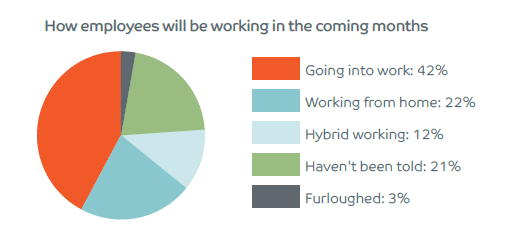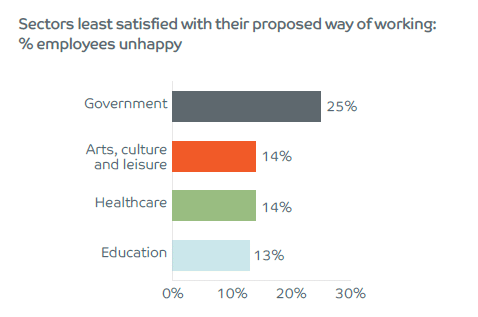In workplaces across the country, change and disruption have become the norm post-lockdown. HR teams have been tasked with creating flexible policies around ever-changing lockdown measures, and many employees have been working in challenging conditions as they switch from furlough, to homeworking, to the Covid secure workplace.
In our latest report, The Future of Work, we asked 1,500 people across the UK about how they’ll be working in the coming months and what support they need from their employer. As lockdown eases, many workers are still unclear on their employer’s expectations for the future, with opinions divided across different sectors.
Uncertainty continues, driving employee anxiety
In May 2021, over a fifth (21%) of workers still hadn’t been told how they’d be expected to work in the following month, leaving them unsure whether they’d be going into the workplace, working from home, on furlough or a combination of these. With over half (51%) of employees reporting that they feel worried about returning to work, this sense of uncertainty will add further strain to an already anxious workforce.
With the UK’s reopening schedule pushed back, businesses have another opportunity to refine their return to work plans and provide a much-needed sense of confidence for their people.
Those on furlough, however, may be facing further unknowns in the coming weeks, as businesses struggle to plan around the changing dates. These employees are the least likely to have been told their future working style, with 31% of those on furlough saying they are yet to receive details of their return to work. With the final steps of lockdown easing still unconfirmed, employers may struggle to provide the security that their people desperately need.
Future working styles
Over the past year, working styles have largely been dictated by Government guidance. When asked about their primary working style, 50% of all employees said they were working from home, with 36% going into their place of work and 14% on furlough.
As restrictions ease, we are seeing a shift in working style and an increase in hybrid approaches.

While more employees will be going into their place of work, over a fifth (22%) will continue to work from home full time. The prevalence of different working styles varies by sector, and the gap between those who can work from home and those can’t looks set to widen over the coming months. In the education sector, for example, 56% of workers will be going into work full time, compared with just 26% of those in professional, technical and scientific services.
Employee responses to working style
Despite on-going uncertainty, most employees (89%) say that they’re happy with their proposed new way of working.
Again, individual sectors report vastly different satisfaction levels. Workers in financial services are the happiest with their working style, with 97% saying they’ll be working in their preferred way.
Government employees are the least happy: a quarter in this sector say they would rather be working differently.

With workplace policies continuing to shift, the majority of people (89%) are happy with how their employer has been communicating plans with them.
Furloughed staff are again struggling in this area, being the most unhappy with the communication they’ve received. Only 28% of those on furlough say they’re ‘very satisfied’ with communication, compared with 49% of employees who’ve been working remotely.
Explore the full report
For more a more detailed breakdown, the Future of Work report provides insight into employee needs as lockdown restrictions ease.
To explore the challenges faced by different sectors, try our quick-reference sector factsheets.